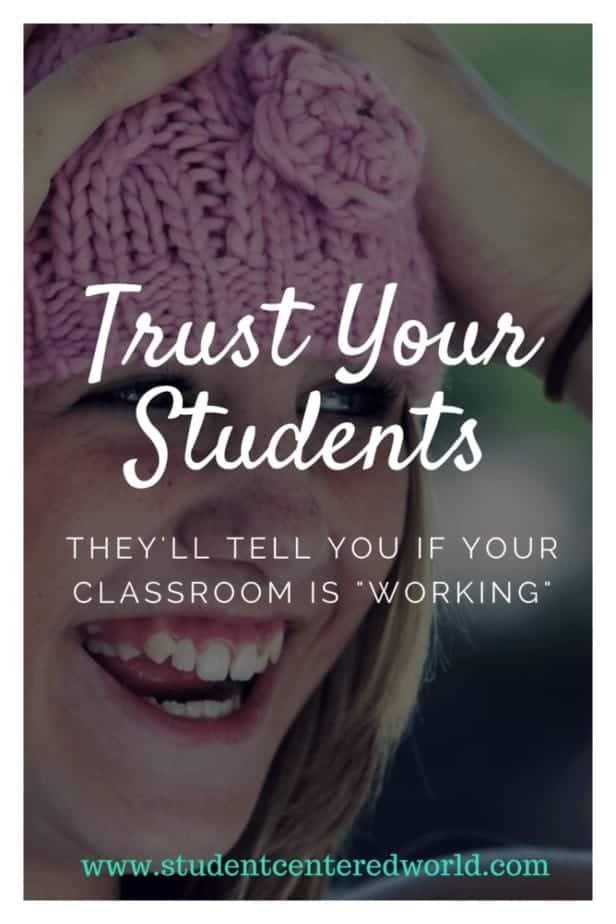Teacher-Directed vs. Student-Centered Instruction: 5 Important Differences
Click above to listen to this podcast episode. Below is the transcript for Student-Centered World Podcast Episode 51: “Teacher-directed vs. student-centered instruction (5 Importance differences)“
Teacher-directed vs. student-centered instruction is a common comparison in today’s educational spectrum. However, there is generally some confusion between not only what each one is, but the similarities and differences between them. The number one piece to remember in both instructional techniques is that wholeheartedly the teacher is 110% in charge of what is going on in the classroom.
So often there is a misconception that the teacher is no longer in charge of a student-led classroom. This couldn’t be further from the truth. Just because their visual role within a classroom full of students is not the same, it does not mean they are not still completely dictating everything that happens.
While the number of similarities between teacher-directed vs student-centered instruction is vast, here are five important differences that any educator needs to understand when determining the best method for their classroom.
The main focus in the classroom
The first big difference between teacher-directed vs. student-centered instruction is the actual focus of the classroom. In a traditional classroom, the vision is that the teacher is the center focus of the classroom. They are dictating and orchestrating everything that is happening from the front of the room. As the ”dispenser of knowledge”, it would make sense that all eyes should be focused on the one who seems to be all-knowing and is in charge of giving out that information.
In a learner-centered classroom, the focus is blended. While the teacher is still the “knower of information”, they are not dispensing that information in a traditional sense. More of a focus is on the students, either individually or collaboratively, and the teacher is a facilitator for the instructional activities that are taking place within the classroom.
This puts much less stress on the teacher yet also gives them the opportunity to make sure that every single student is meeting the objectives and expectations set for them. This is the biggest takeaway when debating teacher-directed vs. student-centered instruction…

Let me repeat, student-led instruction is less stressful and more effective.
When I ran my student-centered classroom, one of my favorite things to do on the first day of school was to ask the students to point to where they thought the front of the room was. I would count to three and then every student would then point to the front of the room. I had the room organized in such a way that they literally couldn’t tell where the front of the room was without deeper investigation. (I also had whiteboards and bulletin boards on various walls, so that was not a dead giveaway, either.)
Eventually, somebody would notice the direction of the projector was pointed coming out of the ceiling, and we could all determine that that wall was, in fact, the front of the room.
I had the room set up like this on purpose. Without me having to be the sage on the stage, the need for a “front of the room” was fairly obsolete. The layout of the room needed to help facilitate student-led instruction, and having students sit in rows all facing one direction does the opposite of that.
Dispensing Information with Teacher-Directed vs. Student-Centered Instruction
How information is given to the students is the next difference in teacher-directed vs. student-centered instruction. In a traditional teacher-centered classroom the teacher speaks, and the students take it in. There may be some questions or other interactions, but for the most part, the teacher gives the information and the students listen to it.
In a student-led classroom, while the teacher is still may be giving out information in one form or another, they’re often doing it either in small groups, with individual students, or are modeling what they want the students to be doing. Instead of just giving them content, they are showing them how to use the content.
This leaves students interacting more with a teacher and in a collaborative sense with one another if warranted, increasing those soft skills of communication and effectively working with others.

Student Choice
This is probably one of the bigger differences in teacher-directed vs. student-centered instruction. In a teacher-led classroom, the teacher plans for and spells out every single lesson in its entirety with the specific expectations of what they wish every single student to complete. Very consistently, it is the expectation that the students will complete the same assignments in the same amount of time as directed by the teacher.
A student-led classroom is a little bit different. Often the teacher gives different options that will lead to the exact same outcome as those cookie-cutter assignments. This doesn’t mean having to craft multiple assignments every day, as many educators looking into this model are concerned about. Instead, you can take the same assignment and refocus it through different lenses. For instance, there can be a writing assignment, an artistic assignment, or a speaking assignment.
At the end of the day, they are all the same assignment but their output is different. Even though they are still working on the exact same content and the outcomes will be the same, students having the choice to complete an assignment that piques their own interest is the absolute essence of having this learning style be fully effective.
Again, all students are, in fact, completing the same content material; they’re just doing it in a way that will increase student buy-in and engagement with that information.
Student Evaluation
Even the student evaluation process is different in teacher-directed vs. student-centered instruction. Traditionally, after a teacher is done explaining a topic or a concept, students will be given some type of follow-up work to complete to show their understanding. It is the job of the teacher to find a way to evaluate this information to determine if a student has met the standard that was set for them.
While this is obviously good in theory, we all know there are often gaping holes in the practice of doing this. From students not engaging to copying someone else’s assignment to us just not having enough time to keep up with constant grading, this is not always the best method when attempting to determine if students are on track for learning or if something needs to be revisited (or even glanced over quicker).
With student-centered learning, evaluating the extent of learning falls on the students just as much as it does on the teacher. Grading a student-led activity is more real-time on behalf of the teacher or is based on longer-term observations and rubric-type grading. students also follow along in a variety of different ways, determining if they are ready to move forward or if they want to go deeper within a topic.
This method of evaluation is somewhat difficult to wrap your head around if you haven’t seen it in action, but I assure you when implemented appropriately, it gives much more detailed and specific feedback on students’ progress than any other traditional method does.

On the flip side, it’s also important for a teacher to take student feedback into consideration to determine whether or not their classroom structure is working effectively. This is something that is very scary for a lot of teachers. However, if our lessons and activities are meant to serve our students’ learning and engagement, it is important to make sure that we are hitting the mark in distributing that content, especially when making comparisons of teacher-directed vs. student-centered instruction.
Classroom Volume with Teacher-Directed vs. Student-Centered Instruction
The acceptable level of how loud the classroom is (or should be) is also a key difference between teacher-directed vs. student-centered instruction. In a traditional teacher-led classroom, it is important for students to stay quiet and focused to be able to digest the content that is being given to them. The teacher is just one person and if they are the ones that are in charge of dispersing information to the students, it is important that everyone had the opportunity to hear them clearly.
Think about this concept just as I have written it. Every single student must 100% pay attention at all times in order to take in the information. With the average person having an attention span of eight seconds, it is nearly impossible for every single student to be paying full attention at all times throughout a lecture or other direct instruction lesson. Even as adults we have a difficult time without having our minds wander to another topic, even if it is just momentarily. Our students’ brains are still developing, so if we have difficulty with this as adults, imagine what it is like for a child.
Since a student-centered classroom is more collaborative, noise is actually encouraged. This means that students are actively engaging in the content in one form or another. I’m not saying that it should be so loud that you cannot hear yourself think. I am also not saying that it is a free-for-all and students behave all willy-nilly. The rationale here is that the students are busy engaging with their content material, and that may look (and sound) very different for different students.

One of my favorite stories that I have told many times is when I had a class of sophomores creating time capsules for the 1960s. The room was loud, no doubt. One of my colleagues walked by and picked her head in, wondering what in the world was going on. I invited her in and suggested that she find out from the students themselves. As she wanted around the room she was floored that every question she asked any student she picked was answered thoroughly, and they were excited to show her exactly what they were working on. She honestly could not believe it.
Something else I always believed in was playing music in the classroom. Now, when you’re teaching US History it is easy to “ cheat” by playing music from whatever decade you were learning about. However, in other classes, I had very distinct playlists ranging from student choice (that were very much edited or just a specific genre, ie. Motown) to classical music for when they were studying. I used to laugh when teachers walking by the classroom would do a double-take and ask if they heard what they thought they heard playing in the background.
I’m not going to say that random dance parties erupted at times from staff walking by, but there were definitely some moves showcased right outside my door (much to the students’ delight).
I did not have one student in all of my years of playing music while they were working that did not say that it helped them and kept them more upbeat while they worked. Just another thing to consider when debating teacher-directed vs. student-centered instruction.
Teacher-Directed vs. Student-Centered Instruction: A Summary
Again, the main thing to remember in all of this is that it doesn’t matter if it is teacher-directed vs. student-centered instruction, the teacher is always fully in charge of their classroom. The difference is overall, in a teacher-led classroom, the teacher IS the classroom, being the focus of all things going on. In a student-led classroom, students are more of a part of the process, which naturally engages and differentiates for every single one of them.
When comparing teacher-directed vs. student-centered instruction, it is important to understand the differences in what each approach means for students, parents, and teachers. There are many definitions of teacher-directed vs. student-centered instruction, but regardless of how you define them, they both have their own merits in the academic setting.
As teachers, we have to remember that our job is to make sure that students are meeting objectives that are meant for them. If there is a way to do this that makes it more interesting for them and less stressful for us, why wouldn’t every teacher be looking into teaching in this fashion? It should be a no-brainer, and anyone that I know who has fully made the switch to a student-centered classroom would never, ever go back.
Stop Driving the Teacher Struggle Bus
Are you struggling with student engagement, apathy, or keeping your class on track?
💫💫 There’s hope! 💫💫
Join my free teacher workshop “Choosing Choice” and in just 60 minutes, you’ll craft a practical plan to revitalize your teaching. Discover the magic of student choice in boosting engagement, gain quick implementation ideas, and explore strategies for year-long success.
Unlike overwhelming workshops, my approach guides you in real-time, providing more classroom options, reducing stress, and giving you more personal time.
Plus, you’ll earn a 1-hour professional development certificate and have 7 days of access.
Don’t miss this chance to transform your teaching; click below to secure your spot now!




